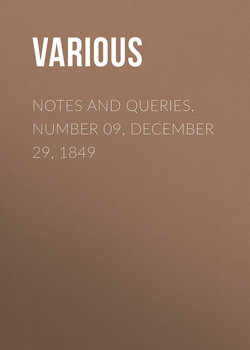Читать книгу Notes and Queries, Number 09, December 29, 1849 - Various - Страница 4
OUR PROGRESS
BISHOP BARNABY
ОглавлениеMr. Editor,—Allow me, in addition to the Note inserted in your 4th Number, in answer to the Query of LEGOUR, by your correspondent (and I believe my friend) J.G., to give the following extract from Forby's Vocabulary of East Anglia:—
"Bishop Barnabee-s. The pretty insect more generally called the Lady-bird, or May-bug. It is one of those highly favoured among God's harmless creatures which superstition protects from wanton injury. Some obscurity seems to hang over this popular name of it. It has certainly no more relation to the companion of St. Paul than to drunken Barnaby, though some have supposed it has. It is sometimes called Bishop Benebee, which may possibly have been intended to mean the blessed bee; sometimes Bishop Benetree, of which it seems not possible to make any thing. The name has most probably been derived from the Barn-Bishop; whether in scorn of that silly and profane mockery, or in pious commemoration of it, must depend on the time of its adoption, before or since the Reformation; and it is not worth inquiring. The two words are transposed, and bee annexed as being perhaps thought more seemly in such a connection than fly-bug or beetle. The dignified ecclesiastics in ancient times wore brilliant mixtures of colours in their habits. Bishops had scarlet and black, as this insect has on its wing-covers. Some remains of the finery of the gravest personages still exist on our academical robes of ceremony. There is something inconsistent with the popish episcopal character in the childish rhyme with which Bishop Barnabee is thrown up and dismissed when he happens to light on any one's hand. Unluckily the words are not recollected, nor at present recoverable; but the purport of them is to admonish him to fly home, and take care of his wife and children, for that his house in on fire. Perhaps, indeed, the rhyme has been fabricated long since the name by some one who did not think of such niceties."
G.A.C.
Sir,—In the explanation of the term Bishop Barnaby, given by J.G., the prefix "Bishop" seems yet to need elucidation. Why should it not have arisen from the insect's garb? The full dress gown of the Oxford D.D.—scarlet with black velvet sleeves—might easily have suggested the idea of naming the little insect "Dr. Burn bug," and the transition is easy to "Dr. Burnabee," or "Bishop Burnaby." These little insects, in the winter, congregate by thousands in barns for their long slumber till the reappearance of genial weather, and it is not impossible that, from this circumstance, the country people may have designated them "Barn bug," or "Barn bee."
L.B.L.
Sir,—I cannot inform LEGOUR why the lady-bird (the seven-spotted, Coccinella Septempunctata, is the most common) is called in some places "Bishop Barnaby." This little insect is sometimes erroneously accused of destroying turnips and peas in its larva state; but, in truth, both in the larva and perfect state it feeds exclusively on aphides. I do not know that it visits dairies, and Tusser's "Bishop that burneth," may allude to something else; still there appears some popular connection of the Coccinellidæ with cows as well as burning, for in the West Riding of Yorkshire they are called Cush Cow Ladies; and in the North Riding one of the children's rhymes anent them runs:—
"Dowdy-cow, dowdy-cow, ride away heame,
Thy1 house is burnt, and thy bairns are tean,
And if thou means to save thy bairns
Take thy wings and flee away!"
The most mischievous urchins are afraid to hurt the dowdy-cow, believing if they did evil would inevitably befall them. It is tenderly placed on the palm of the hand—of a girl, if possible—and the above rhyme recited thrice, during which it usually spreads its wings, and at the last word flies away. A collection of nursery rhymes relating to insects would, I think, be useful.
W.G.M.J. BARKER.
1
Thy is pronounced as thee.
[We have received many other communications respecting the epithet of this insect—so great a favourite with children. ALICUI and several other correspondents incline to L.B.L.'s opinion that it takes its name from a fancied resemblance of its bright wing-cases to the episcopal cope or chasuble. J.T. reminds us that St. Barnabas has been distinguished of old by the title of bright, as in the old proverbial distich intended to mark the day of his festival according to the Old Style (21st June):—
"Barnaby bright!
The longest day and the shortest night."
While F.E. furnishes us with another and happier version of the Norfolk popular rhyme:—
"Bishop, Bishop Barnabee,
Tell me when my wedding be;
If it be to-morrow day,
Take your wings and fly away!
Fly to the east, fly to the west,
Fly to them that I love best!"
The name which this pretty insect bears in the various languages of Europe is clearly mythic. In this, as in other cases, the Virgin has supplanted Freya; so that Freyjuhaena and Frouehenge have been changed into Marienvoglein, which corresponds with Our Lady's Bird. There, can, therefore, be little doubt that the esteem with which the lady-bird, or Our Lady's cow, is still regarded, is a relic of the ancient cult.]
